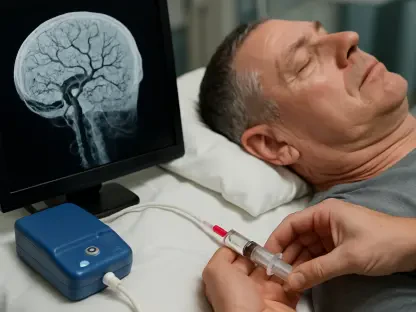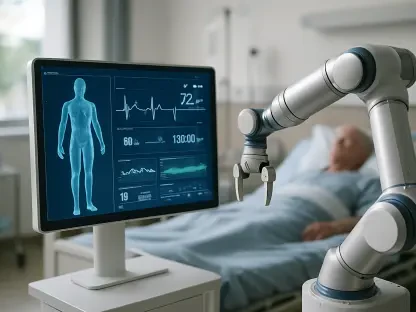Imagine a world where a single drop of blood can reveal not just a current illness but also predict future health risks with pinpoint accuracy, guiding personalized treatment plans before symptoms even appear. This vision is quickly becoming a reality as clinical laboratory testing evolves at an unprecedented pace. Projections estimate the market for these tests will soar to an impressive $225.8 billion by 2034, driven by technological breakthroughs, demographic shifts, and changing healthcare needs. The landscape of medical diagnostics is undergoing a profound transformation, fueled by an aging population, the rising burden of chronic diseases, and a growing emphasis on preventive care. As testing becomes more accessible through diverse settings like hospitals, independent labs, and even at-home options, the industry stands on the cusp of redefining patient care. This article delves into the forces propelling this growth and explores how these advancements promise to reshape the future of healthcare over the next decade.
Emerging Trends Shaping the Diagnostic Landscape
Technological Innovations Driving Efficiency
The rapid modernization of clinical laboratories through cutting-edge technology is fundamentally altering how diagnostics are performed. Automation, high-throughput analyzers, and integrated systems that link instruments with laboratory information systems (LIS) and electronic health records (EHRs) are streamlining operations. These advancements significantly reduce turnaround times while enhancing quality control and operational efficiency. The incorporation of artificial intelligence (AI) for decision support and quality assurance marks a leap forward, enabling labs to handle complex data with greater accuracy. Moreover, the rise of multiplex molecular panels and companion diagnostics is broadening test offerings, particularly in precision fields like molecular oncology and pharmacogenomics. This shift toward tailored medical solutions reflects a broader trend of personalization in healthcare, ensuring that patients receive treatments aligned with their unique genetic profiles and health needs.
Beyond automation and AI, the push for digital integration is transforming workflows in ways previously unimaginable. Connected systems allow seamless data sharing between labs and healthcare providers, minimizing errors and improving patient outcomes. Emerging tools in infectious disease testing and women’s health are also gaining traction, supported by innovations that prioritize speed without sacrificing accuracy. As these technologies mature, they pave the way for a future where diagnostics are not just reactive but predictive, identifying risks long before they manifest into serious conditions. The focus on precision medicine is evident as labs adopt platforms that support individualized care, a trend that will likely intensify over the coming years. With such tools, the industry is moving toward a model where every test contributes to a deeper understanding of a patient’s health trajectory, fundamentally changing the role of diagnostics in medicine.
Demographic and Disease Trends Fueling Demand
An aging global population is placing unprecedented pressure on healthcare systems, driving the need for more frequent and comprehensive diagnostic testing. As life expectancy rises, so does the prevalence of chronic conditions like diabetes and cardiovascular diseases, necessitating regular monitoring and early intervention. The demand for preventive screening and infectious disease surveillance has surged in response, pushing labs to expand their capabilities. This demographic shift is complemented by a growing awareness of health management, with patients seeking proactive measures to maintain wellness. Clinical tests spanning routine chemistry, hematology, microbiology, and urinalysis are becoming cornerstones of this approach, conducted across diverse settings from hospitals to point-of-care and at-home platforms, reflecting a move toward patient-centered accessibility.
In parallel, the evolving nature of disease patterns is reshaping the priorities of lab testing. The rise in complex conditions such as cancer and cardiometabolic disorders calls for advanced diagnostics like molecular testing and transplant monitoring. These high-value tests focus on outcomes rather than sheer volume, aligning with the industry’s shift toward quality-driven care. Additionally, public health challenges, including pandemics, have underscored the importance of rapid-response testing for infectious diseases, prompting labs to adapt swiftly to emerging threats. As these trends converge, the market is witnessing a diversification of testing channels, ensuring that diagnostics reach broader populations. This adaptability highlights the critical role of labs in addressing both current and future health challenges, setting the stage for sustained growth through 2034.
Challenges and Opportunities on the Horizon
Navigating Regulatory and Operational Hurdles
Despite the promising growth trajectory, the clinical lab testing industry faces significant obstacles that could temper its expansion. Regulatory changes and pricing pressures pose constant challenges, requiring labs to continuously adapt to new compliance standards while maintaining affordability. Supply chain disruptions further complicate the landscape, often delaying the availability of critical reagents and equipment. Workforce shortages, particularly in skilled technologists, add another layer of difficulty, straining lab capacity to meet rising demand. Additionally, ensuring data security and interoperability remains paramount as digital tools become more integrated into workflows. Labs must prioritize compliance with stringent standards to maintain trust and operational integrity, a task that grows more complex with each technological advancement.
Compounding these issues is the pressure from value-based care models, which demand that labs demonstrate both clinical utility and cost-effectiveness. This has spurred a wave of consolidation, with health systems centralizing core testing and independent lab chains leveraging economies of scale to stay competitive. Rapid-response labs are also emerging to address urgent needs, balancing speed with accuracy under tight constraints. Meanwhile, consumer-initiated testing platforms are gaining ground, reflecting a shift toward patient empowerment but also raising questions about quality control. Addressing these multifaceted challenges will require strategic partnerships and innovative solutions, ensuring that labs can navigate this complex environment while continuing to deliver reliable results. The path forward hinges on balancing operational resilience with the evolving expectations of healthcare stakeholders.
Capitalizing on High-Growth Testing Areas
Amid these challenges lie significant opportunities for growth, particularly in specialized testing domains that promise to redefine medical care. Molecular diagnostics, oncology, and infectious disease testing stand out as key areas poised for expansion, driven by their ability to deliver precise, outcome-focused results. Cardiometabolic risk assessment and transplant monitoring are also gaining prominence, addressing critical needs in chronic disease management and personalized care. These sectors benefit from a market shift toward high-value testing, where the emphasis is on improving patient outcomes rather than simply increasing test volumes. As labs invest in these areas, they position themselves at the forefront of healthcare innovation, meeting the demands of an increasingly complex medical landscape.
Equally important is the integration of connected workflows and patient-centered access models, which are reshaping service delivery. By prioritizing quality and accreditation, labs ensure that expanded access does not come at the expense of reliability. Strategic partnerships among assay developers, equipment manufacturers, and lab networks are accelerating the rollout of new tests, fostering a collaborative environment for innovation. Sustainability initiatives, such as reducing reagent waste and adopting energy-efficient equipment, are also becoming key priorities, aligning with broader environmental goals. Looking back, the industry demonstrated remarkable adaptability in addressing past hurdles, and these efforts laid the groundwork for future success. Moving forward, labs must continue to embrace emerging opportunities, invest in cutting-edge technologies, and build resilient systems to sustain this transformative momentum through 2034 and beyond.









